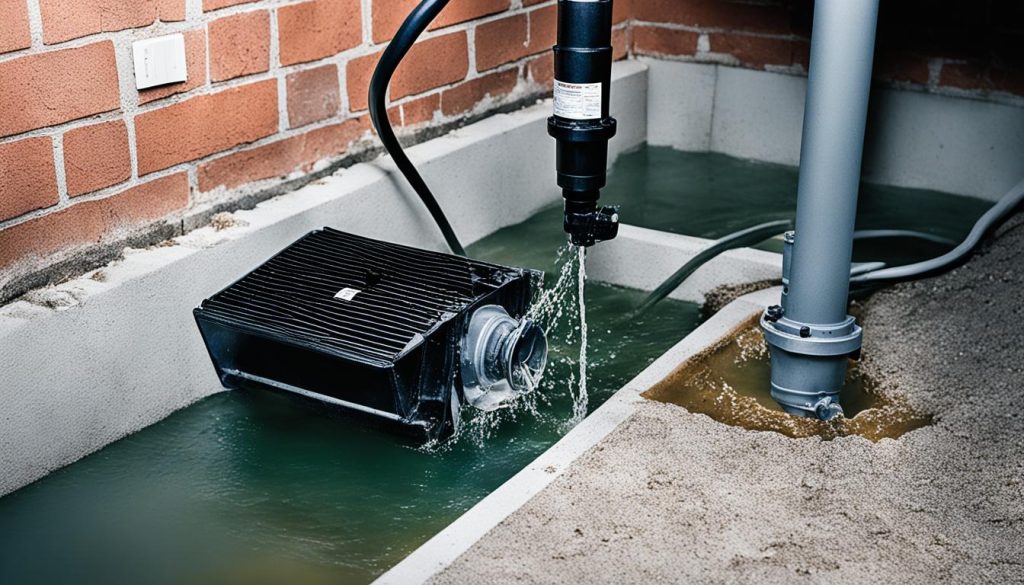Sump Pump Prices: Affordable Solutions for Homes
Did you know that water damage costs Canadian homeowners an estimated $13 billion annually?
Water damage can wreak havoc on your home, causing extensive repairs and posing health risks. Fortunately, there is a cost-effective solution that can help mitigate the risk of water damage: a sump pump. In this article, I will explore sump pump prices in Canada and provide affordable options that can keep your home dry without breaking the bank.
Key Takeaways:
- Water damage costs Canadian homeowners an estimated $13 billion annually.
- A sump pump is a cost-effective solution to prevent water damage in your home.
- In this article, you will find affordable sump pump options suitable for any budget.
- Investing in a sump pump can save you from costly repairs and provide peace of mind.
- Protect your home and belongings by installing a sump pump today.
What is a Sump Pump?
A sump pump is a crucial device for safeguarding your basement or below-ground level floor from flooding and water damage. It functions by using a motor unit equipped with water-level or pressure sensing valves to pump water out of one area and discharge it away from your home. By efficiently collecting and removing excess water, sump pumps play a vital role in preventing water damage that can lead to issues such as warping, mold growth, and structural damage. Installing a sump pump in your home provides peace of mind and protects your investment in preventing basement water damage.
How does a Sump Pump work?
A sump pump operates through a straightforward mechanism. It is typically placed in a specially constructed pit, known as a sump pit, located at the lowest point in your basement or crawl space. When the water level in the pit reaches a certain point, the motor unit of the sump pump is activated. The motor powers the pump, which then removes the water by either pumping it out through a discharge pipe or utilizing a drainage system.
As water enters the pit, the sump pump’s sensors detect the rising water level, triggering its operation. By promptly removing the excess water, sump pumps actively prevent water damage and basement flooding. It is essential to ensure that your sump pump is regularly maintained to guarantee its optimal performance in protecting your basement from water accumulation.
Benefits of having a Sump Pump
- Prevents basement water damage: A sump pump is a reliable solution for preventing basement water damage. By efficiently removing excess water, it minimizes the risk of floods, mold growth, and structural issues caused by water accumulation.
- Preserves property value: Installing a sump pump helps preserve the value of your property by safeguarding its structural integrity. It prevents potential water damage to your basement or foundation, ensuring your home remains protected and in good condition.
- Reduces the risk of mold and mildew: Excessive moisture in your basement can lead to mold and mildew growth, posing health risks to you and your family. A sump pump effectively reduces the moisture level, minimizing the chances of mold and mildew development.
- Provides peace of mind: Knowing that your basement is equipped with a reliable sump pump offers peace of mind. You can confidently face heavy rains or sudden water buildup, knowing that your sump pump will actively prevent potential water damage.
Why Do I Need a Sump Pump?
If your basement or crawl space is prone to flooding or water buildup, a sump pump is essential. Water damage can cause significant harm to your property and possessions, leading to expensive repairs and health hazards such as mold growth. A sump pump helps ensure that your basement stays dry and free from water damage even during heavy rainfall or flooding. It is a proactive measure to protect your home and maintain its structural integrity.
The Importance of a Sump Pump
A sump pump plays a crucial role in preventing basement flooding and water damage. By collecting and redirecting excess water away from your home, it helps keep your basement dry and reduces the risk of structural damage, mold growth, and the associated health hazards.
The Benefits of a Sump Pump
Investing in a sump pump provides numerous benefits, including:
- Prevention of basement flooding and water damage
- Protection of your property and possessions
- Reduction in potential health hazards, such as mold growth
- Preservation of the structural integrity of your home
- Increased peace of mind, especially during heavy rainfall or flooding
| Benefits of a Sump Pump | Description |
|---|---|
| Prevention of basement flooding and water damage | A sump pump efficiently collects and removes excess water, preventing it from entering your basement and causing costly damage. |
| Protection of your property and possessions | By keeping your basement dry, a sump pump safeguards your belongings from water damage, preserving their value and functionality. |
| Reduction in potential health hazards, such as mold growth | Excess moisture in basements creates an ideal environment for mold to thrive. A sump pump helps eliminate water and moisture, minimizing the risk of mold-related health issues. |
| Preservation of the structural integrity of your home | Continuous water exposure can weaken the foundation and structure of your home. By keeping your basement dry, a sump pump helps maintain the overall integrity and stability of your property. |
| Increased peace of mind, especially during heavy rainfall or flooding | Knowing that you have a reliable sump pump installed provides peace of mind, allowing you to rest easy knowing your basement is protected and your home is safeguarded from potential water damage. |
Cost of a Sump Pump Installation
The cost of installing a sump pump can vary based on different factors. On average, professional installation, including the sump pump unit, labor, and materials, can range from $1,200. However, if you prefer a do-it-yourself approach, the cost can be lower, starting from $250 to $375 for the sump pump unit alone. Nevertheless, it’s essential to consider additional factors that can impact the overall cost.
One of the primary cost factors is the type of sump pump chosen. There are two main types: pedestal and submersible sump pumps. Pedestal sump pumps are generally less expensive, with prices ranging from $75 to $200 for the unit. On the other hand, submersible sump pumps typically cost more, ranging from $90 to $1,000 for the unit, due to their greater efficiency and performance.
Another cost consideration is whether you’re replacing an existing sump pump or installing a new one. While replacement installations may require additional labor and material expenses, new installations may involve additional costs such as excavation or creating a sump pit.
Add-on features or units can also impact the cost. Some sump pumps come with extra features like battery backup systems or Wi-Fi connectivity, which can raise the overall price. Additionally, the cost may increase if you need to prepare the flooring or address pre-existing water buildup or damage in your basement.
The geographical location and necessary permits can affect the installation cost. It’s important to check with local authorities to determine whether any building codes or permits are required for sump pump installations in your area.
Deciding between professional installation and DIY can also affect the cost. While professional installation ensures expert handling and a guarantee of quality workmanship, it may come at a higher price. On the other hand, opting for a DIY installation can save you money, but it might require more time, effort, and the need for specialized tools.
Factors Impacting Sump Pump Installation Cost:
- Type of sump pump chosen
- Replacement vs. new installation
- Add-on features or units
- Flooring preparation requirements
- Pre-existing water buildup or damage
- Geographical location and permits
- DIY vs. professional installation
Considering all these factors will help you estimate the total cost of a sump pump installation accurately.
Types of Sump Pumps and Their Costs
When it comes to sump pumps, there are two main types to consider: pedestal sump pumps and submersible sump pumps. Each type has its own advantages and varying costs.
Pedestal Sump Pumps
Pedestal sump pumps feature a separate motor and pump design. These pumps are generally less expensive compared to their submersible counterparts, making them a budget-friendly choice for homeowners. The cost of a pedestal sump pump typically ranges from $75 to $200 for the unit.
While pedestal sump pumps are more affordable, they do have some trade-offs. They tend to have a longer lifespan due to the motor being located above the sump pit. However, they can be noisier during operation due to the exposed motor. Additionally, pedestal sump pumps take up more space, so homeowners with limited space in their basements may need to consider this factor.
Submersible Sump Pumps
Submersible sump pumps differ from pedestal pumps as they combine the motor and pump into a single unit. This design offers quieter operation and better overall performance. However, submersible sump pumps tend to be pricier, ranging from $90 to $1,000 for the unit.
The cost difference between submersible and pedestal sump pumps can be attributed to their performance and convenience. Submersible pumps are more powerful and can handle larger volumes of water, making them ideal for areas with frequent flooding. They also provide a sleeker appearance since the motor is submerged in the sump pit.
To determine which type of sump pump is best for your needs, consider factors such as the severity of flooding in your area, available space in your basement, and personal preferences for noise levels and performance.
| Sump Pump Type | Cost Range | Lifespan | Performance |
|---|---|---|---|
| Pedestal Sump Pump | $75 – $200 | Longer | Louder |
| Submersible Sump Pump | $90 – $1,000 | Shorter | Quieter |
Additional Factors Impacting the Cost
When determining the overall cost of your sump pump installation, it’s important to consider several additional factors that can impact the final price. These factors include the type of sump pump chosen, whether it’s a replacement or new installation, the inclusion of extra features or units, flooring preparation requirements, the presence of pre-existing water buildup or damage, location-related factors such as permits, and the choice between DIY and professional installation.
Type of Sump Pump
The type of sump pump you choose will affect the cost of installation. There are two main types: pedestal and submersible sump pumps. Pedestal pumps are generally less expensive, with prices ranging from $75 to $200 for the unit. Submersible pumps, on the other hand, are more expensive, ranging from $90 to $1,000 for the unit. Consider factors such as the severity of flooding, available space, and personal preference when deciding which type of sump pump to install.
Replacement vs. New Installation
If you’re replacing an existing sump pump, the installation cost may be lower compared to a new installation. However, if there is no existing sump pump system in place, the installation process may be more complex and require additional materials and labor, potentially increasing the overall cost.
Extra Features or Units
Sump pump systems can come with extra features or units, such as battery backups or water level alarms, which can enhance the performance and reliability of the system. These additional features may incur added costs, so consider your specific needs and budget when deciding whether to include them in your sump pump installation.
Flooring Preparation
Depending on the type of sump pump and the location of your installation, flooring preparation may be required. This can involve removing and replacing flooring materials, which may add to the overall installation cost. Discuss with your installer if flooring preparation is necessary and if it’s included in the installation package.
Pre-existing Water Buildup or Damage
If your basement already has water buildup or damage, additional measures may be needed to address these issues before the sump pump installation. This remediation work can impact the overall cost, so it’s important to address any pre-existing water issues before proceeding with the installation.
Location and Permits
Depending on your location, permits may be required for sump pump installations. These permits can come with associated fees, which should be factored into the overall cost. Additionally, the location of the installation, such as the accessibility of the basement or crawl space, can also impact the installation cost.
DIY vs. Professional Installation
You may choose to install a sump pump yourself to save on labor costs. DIY installations can be more affordable, ranging from $250 to $375 for the sump pump unit alone. However, keep in mind that sump pump installations require technical expertise, and any mistakes can lead to inefficiencies or system failures. Hiring a professional for the installation ensures proper installation and peace of mind, but it may come at a higher cost.
Considering these additional factors alongside the price of the sump pump unit itself will help you accurately estimate the total cost of your sump pump installation. It’s important to find the right balance between your budget and the requirements of your specific property to ensure a successful and cost-effective installation.
Benefits of Investing in a Sump Pump
Investing in a sump pump may require an initial cost, but the long-term benefits make it a wise decision. The potential costs of water damage and repairs far outweigh the expense of installation. By having a properly installed and maintained sump pump, you can effectively protect your home from water damage and preserve the integrity of your foundation.
A sump pump acts as a reliable defense against basement flooding, preventing costly damage to your belongings and structural elements. It efficiently collects and removes excess water, ensuring your basement stays dry even during heavy rainfall or flooding. With this reliable home protection, you can have peace of mind knowing that your basement is safeguarded against potential water damage.
Moreover, investing in a sump pump offers long-term cost savings. By preventing water damage, you avoid expensive repairs and potential health hazards, such as mold growth. This proactive measure helps you maintain the value and integrity of your home, saving you money in the long run.
- Investing Wisely: How Windows & Doors in Boost Property Value and Financial Health - April 24, 2025
- The Financial Impact of Personal Injuries: Why Legal Help Matters for Business Owners - April 16, 2025
- The Hidden Financial Costs of Domestic Assault: What Business Owners Need to Know - April 16, 2025














